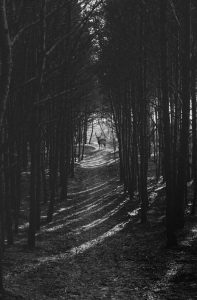When I’m 8, I use my grandmother’s boxy computer and Comic Sans 14-pt font to write stories about girls who don’t fit in, but who still manage to go on adventures. In fact, they’re better suited for adventures because they don’t fit in. Since they don’t have a place in the world, there’s nothing holding them back and they don’t need anyone’s help. (I’m too young to worry about author intrusion.)
Around 15, my stories become about teens tasked with saving others and stopping evil. They’re always outcasts and traumatized (though I don’t think of them that way at the time). Their powers are often elemental and destructive, their pain can burn their homes to ash, turn their friends to enemies. (Their fathers are dead because my father is dead.) They’re unlikely saviors, maybe too broken for the challenges they face, but they know what it’s like to be lonely and afraid and in need of saving, and they won’t leave anybody else to feel that way.
In my early 20s, I stop reading and writing for fun. It’s not that I don’t miss flying with dragons or kissing boys with cold lips and even colder hearts, but I can’t afford to escape reality. (I would never come back.)
In my late 20s, I start the slow process of scraping off the emotional grime that’s insulated (stifled) me. I get a library card and listen to audiobooks on the bus. I rediscover the fantasies and the futures that took me in when the real world wasn’t safe. (Funny how finding a home can free you to travel.)
Now, in my 30s, the stories I love have changed and matured with me. I write for all the girls and not-girls I was, as well as the unfathomable being I aspire to be. And while my reading now takes me across many genres and styles, there will always be a special place in my heart and room at my table for the misfits. Even if we have to add a chair or two and get real cozy with each other, we’re making the space.
Which brings me to the most exciting part: sharing creative work that I loved!
The Apparition Lit team and I have brought together four stories that are often as uncanny as they are familiar, and as often windows as they are mirrors: “Through the Glass, a Full Sea” by P.H. Low, “Tavern Tale” by Mare Knaupp, “The Sea Hare” by Wailana Kalama, and “A Catalog of Gifts from a Crow” by Jo Miles.
We have also four incredible poems for you: “Helen After Helen” by Rasha Abdulhadi, “Hunger” by Nnadi Samuel, “Invertebrate Gazebo” by Angela Acosta, and “Marriage” by Yee Heng Yeh.
And lastly, we’ve been graced with an essay by Tania Chen called “Symmetry, Horror & Identity.”
Originally, I wanted to talk about the parallels in theme and subject matter I saw throughout the issue, but I don’t want to spoil anything, and besides, now I’m curious: What similarities do you find? I wonder if we’ll see eye to eye.
Kel Coleman is a mom, editor, and Ignyte-nominated author. Their fiction has appeared or is forthcoming in FIYAH, Anathema: Spec from the Margins, Apparition Lit, The Best American Science Fiction and Fantasy 2022, and others. Though Kel is a Marylander at heart, they currently live in Pennsylvania with their husband, tiny human, and a stuffed dragon named Pen. They can be found at kelcoleman.com and on Twitter at @kcolemanwrites.
Apparition Literary Magazine is funded by our patrons, the editors, and by your kind donations. If you’d like to support us, you can follow us on Facebook or Twitter and please consider donating and/or subscribing via Patreon.
Thank you for reading
Rebecca Bennett, Amy Henry Robinson, Tacoma Tomilson, and Clarke Doty






